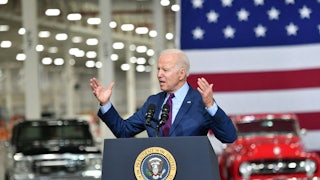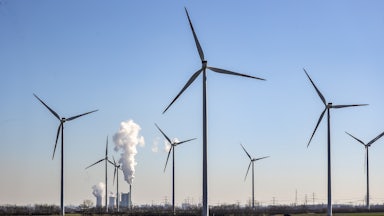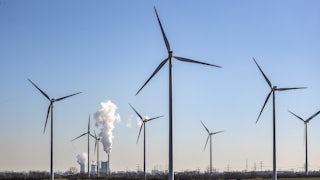Between the year when Robert Pattinson starred in The Twilight Saga: Eclipse and the year he starred in The Lighthouse, the planet emitted an amount of carbon dioxide that—if it’s emitted again—will likely push it to warm by 1.5 degrees Celsius (2.7 degrees Fahrenheit). So in the time it takes another teen heartthrob to transform into a rakish indie darling, the world may have sped past the threshold between life and death for the people and places already bearing the brunt of the climate crisis. That’s one takeaway from the latest installment of the Intergovernmental Panel on Climate Change’s Sixth Assessment Report, dealing with climate mitigation.
But there’s a distinction between what’s in the full, nearly 3,000-page report crafted from 18,000 peer-reviewed papers by the IPCC’s Working Group III and what made it into the 63-page Summary for Policymakers. Specifically, you’d be hard pressed to find direct language about the need to phase out coal, oil, and gas in the synopsis account, gruelingly edited by government representatives during the longest approval plenary in IPCC history.
The full report paints a stark picture of the consequences of continued fossil fuel use: “If existing fossil-fuel infrastructure would continue to be operated as historically, they would entail CO2 emissions exceeding the carbon budget for 1.5°C.” Authors add that 30, 50, and 80 percent of proven oil, gas, and coal reserves (respectively) must remain unburned to limit warming to two degrees Celsius, and “significantly more” to limit warming to 1.5 degrees Celsius. Reaching that goal, they add, would entail closing coal- and gas-fired power plants 30 years ahead of schedule. The report cites a 2018 study finding that even if every pipeline currently planned were canceled, one-fifth of existing fossil fueled generation capacity would still need to be shut down, as well.
The Summary for Policymakers includes some references to that. Limiting warming to two degrees, it notes, could wipe out between $1 and $4 trillion worth of fossil fuel assets by 2050 and “significantly more” to meet a 1.5 degree goal. Either “will leave a substantial amount of fossil fuels unburned and could strand considerable fossil fuel infrastructure,” per the summary. But the next sentence provides a convenient out: “Depending on its availability, [carbon capture and sequestration] could allow fossil fuels to be used longer, reducing stranded assets.” As in other sections, the Summary for Policymakers envisions a rosier picture for coal, oil, and gas than the report itself.
In the Monday press conference announcing the report, the person who most clearly urged countries to ditch fossil fuels was U.N. Secretary General António Guterres. “Climate activists are sometimes depicted as dangerous radicals. But the truly dangerous radicals are the countries increasing the production of fossil fuels,” he said in opening remarks. “Investing in new fossil fuel infrastructure is moral and economic madness.” But amid rising gas prices and Russia’s war in Ukraine, the United States and the European Union—governments that should be transitioning the fastest—are investing in new fossil fuel infrastructure that could lock in emissions for decades to come. As the report was released Monday, progressive Democrats were coming around to the idea of boosting fossil fuel production and infrastructure, too, in order to strike a deal for temporary clean-energy tax credits with Senator Joe Manchin.
Like energy policy in the U.S., the IPCC’s summaries for policymakers are subject to political pressures from fossil fuel interests. Summaries are initially drafted in bite-size 300-word increments by subject-area experts who then fight for space about what can be included. In the two weeks before the report is released, governmental delegations go line by line through that text and negotiate over what gets included and what doesn’t. As a result of haggling by some of the world’s biggest polluters, the most recent summary presents a broad and euphemistic menu of routes toward a “substantial reduction in fossil fuel use,” many of which involve technologies that remain infeasible. For example, this most recent summary heavily emphasizes carbon capture and sequestration, or CCS, arguing that “decommissioning and reduced utilization of existing fossil fuel based power sector infrastructure, retrofitting existing installations with CCS, switches to low carbon fuels and cancellation of new coal installations without CCS are major options” for meeting emissions targets. That’s despite abundant evidence that carbon capture isn’t as easy or as effective as many want it to be.
So which governments pushed for these modifications? “To me the extremes are the U.S., Saudi Arabia, and India,” someone involved in drafting the report who attended the approval plenary and asked to remain anonymous told me. Saudi Arabia was particularly active this year, pushing to excise clear language about phasing out fossil fuels and criticisms of carbon dioxide removal. As Climate Home News’s Chloé Farand reported, the oil-exporting country fought to include several references to commercially unproven technologies that could extend the life of coal, oil, and gas assets. “The Saudis tried to remove the word ‘carbon’ from almost all sections” and replace it with ‘greenhouse gases,’ the source said.
Another notable wording tweak involves the word “unabated,” as in “unabated” coal or gas-fired power plants that don’t capture some segment of the emissions they produce. The word “unabated” appears sporadically in the full report and not at all in the 145-page technical summary. It’s foregrounded in the Summary for Policymakers, however, where references to the need to phase out fossil fuels were qualified to name only “unabated” fossil fuels or those without CCS as the problem. Critics argue that leaves the door open to continued fossil fuel development, by implying that existing and new infrastructure can be easily outfitted with technology that—per the IPCC’s definition—eliminates at least 90 percent of its carbon emissions. These capacities don’t yet exist at any meaningful scale, and fossil fuel–producing governments have consistently fought to exclude recognition of the considerable challenges they face from the summary; only one sentence on this appeared in its final version, although there’s an extended discussion about it in the full text.
Experts caution that the use of negative emissions technologies, while very likely necessary, should be limited mostly to industrial sectors in which low-carbon alternatives are far off, like steel and cement. In the power sector, renewables are much cheaper and more viable options for decarbonization. “That word [“unabated”] is inserted precisely to perpetuate the myth that the world still can keep using fossil fuels without harming people and the planet, which doesn’t square with the science,” said Nikki Reisch, director of the Climate and Energy Program at the Center for International Environmental Law.
The U.S. sent a large delegation to negotiate the Summary for Policymakers text, led by the State Department and including veteran U.N. Framework Convention on Climate Change negotiator Trigg Talley and Foreign Affairs Officer Farhan Akhtar. Consistent with U.S. positions in U.N. climate talks, where the U.S. has tried to keep talk of wealthy nations’ responsibility for the climate crisis off the table, this delegation sought to remove distinctions between developed and developing nations, as well as references to the $100 billion in climate finance rich countries have yet to furnish. A graphic illustrating the gap between provided and pledged financing was stripped out of the summary after being included in an earlier draft, Farand reported.
Insiders say the U.S. delegation was relatively quiet about fossil fuels in this round of summary editing but didn’t seem to have raised many objections to the changes pushed by Saudi Arabia. “The U.S. is very pushy for technological solutions,” the source said. “Per capita emissions are very high in the U.S. They don’t want wording that shows this kind of thing.”
Focusing solely on the debates about the Summary for Policymakers, though, can overlook longer-standing challenges within the IPCC process itself. Less than a third of Working Group III members in this assessment round, for instance, are women, and representation is weighted heavily toward academics from rich nations. “It’s very North-centric; Anglo-Saxon white males,” the source said. Compounding those issues is the fact that IPCC proceedings take place almost entirely in English. The approval plenary for the Summary for Policymakers—translated into “four or five languages,” the source said—was the first time any translation support had been provided. That’s an issue, as well, for certain subfields where academic literature isn’t primarily written in English.
There are also structural difficulties that have less to do with the IPCC process itself than the challenges of academic research. Some Working Group III authors and editors are directly employed either by industry-friendly groups or actual fossil fuel companies, like Saudi Aramco, Chevron, and the International Chamber of Commerce. But required conflict-of-interest disclosures don’t preclude industry funding for academic research, which can inform both authors’ perspectives and the research compiled in the report. Scientists have long criticized the fact that the scenarios the IPCC considers place an outsize emphasis on negative emissions technologies. Economists also proliferate in Working Group III, coming from a field that’s notoriously exclusionary and hostile to new thinking and frequently criticized for taking a narrow approach to the climate crisis that prioritizes economic growth above all else. The IPCC, the source said, is “only a place where you summarize the literature. If the vast majority of the research is neoliberal thinking, then this is what is reported in the IPCC. It’s not the IPCC’s fault.”
As war rages on in Europe, the IPCC’s report barely registered. One of the world’s biggest emitters—the United States—is moving in the opposite direction from the IPCC’s recommendations. Over the last few weeks, the White House has indicated that it wants to have two contradictory things: permanently low gas prices and a world where warming is limited to 1.5 degrees Celsius. Last week Biden announced that he’ll release one million barrels per day from the Strategic Petroleum Reserve for six months, a move that will allow the administration to boost production by guaranteeing that it will purchase barrels from drillers to refill the SPR at more stable prices than they can fetch on the market. He also said he’d like to fine producers who aren’t drilling faster. “I don’t think the goals are mutually exclusive,” EPA head Michael Regan said recently of boosting oil production and Biden’s climate goals. The IPCC’s latest report strongly suggests that they are.










